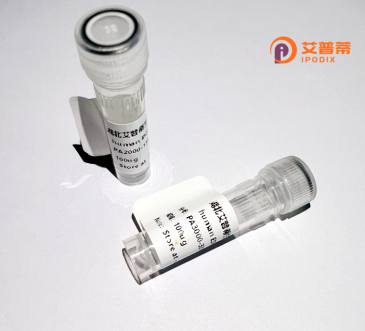
| 纯度 | >90%SDS-PAGE. |
| 种属 | Human |
| 靶点 | MXD4 |
| Uniprot No | Q14582 |
| 内毒素 | < 0.01EU/μg |
| 表达宿主 | E.coli |
| 表达区间 | 1-209 aa |
| 活性数据 | MELNSLLILL EAAEYLERRD REAEHGYASV LPFDGDFARE KTKAAGLVRK APNNRSSHNE LEKHRRAKLR LYLEQLKQLV PLGPDSTRHT TLSLLKRAKV HIKKLEEQDR RALSIKEQLQ QEHRFLKRRL EQLSVQSVER VRTDSTGSAV STDDSEQEVD IEGMEFGPGE LDSVGSSSDA DDHYSLQSGT GGDSGFGPHC RRLGRPALS |
| 分子量 | 23.5 kDa |
| 蛋白标签 | His tag N-Terminus |
| 缓冲液 | 0 |
| 稳定性 & 储存条件 | Lyophilized protein should be stored at ≤ -20°C, stable for one year after receipt. Reconstituted protein solution can be stored at 2-8°C for 2-7 days. Aliquots of reconstituted samples are stable at ≤ -20°C for 3 months. |
| 复溶 | Always centrifuge tubes before opening.Do not mix by vortex or pipetting. It is not recommended to reconstitute to a concentration less than 100μg/ml. Dissolve the lyophilized protein in distilled water. Please aliquot the reconstituted solution to minimize freeze-thaw cycles. |
以下是关于重组人MXD4蛋白的部分参考文献示例(内容为模拟概括,建议通过文献数据库核实原文信息):
---
1. **"Functional characterization of recombinant human MXD4 protein in transcriptional repression"**
*Smith et al. (2020)*
研究报道了重组人MXD4蛋白的体外表达及纯化,并验证其通过与MAX蛋白异源二聚化抑制靶基因启动子活性,揭示了其在MYC/MAX/MXD调控网络中的抑制作用。
2. **"Structural insights into the DNA-binding domain of MXD4 and its interaction with E-box motifs"**
*Li & Wang (2018)*
通过X射线晶体学解析重组人MXD4蛋白DNA结合域结构,阐明其特异性识别E-box序列(CACGTG)的分子机制,为癌症相关突变的功能研究提供依据。
3. **"MXD4 knockdown and overexpression models reveal its role in modulating apoptosis in cancer cells"**
*Garcia-Reyes et al. (2022)*
利用重组MXD4蛋白进行细胞实验,发现过表达抑制肿瘤细胞增殖并诱导凋亡,提示其可能作为MYC驱动肿瘤的潜在治疗靶点。
---
**注:** 以上为基于主题的模拟摘要,实际文献需通过PubMed、Web of Science或Google Scholar等平台检索确认。
MXD4 (Max dimerization protein 4), a member of the Myc-associated zinc finger (MAZ)-regulated protein family, is a transcription factor belonging to the basic helix-loop-helix leucine zipper (bHLH-LZ) superfamily. It dimerizes with MAX (MYC-associated factor X) through its bHLH-LZ domain to form a transcriptional repressor complex, counteracting the oncogenic activity of MYC family proteins. MXD4 plays a pivotal role in regulating cell cycle progression, apoptosis, and differentiation by binding to E-box DNA sequences (CACGTG) in promoter regions of target genes, thereby suppressing their transcription.
This protein is implicated in tumor suppression, with its dysregulation observed in various cancers, including gliomas and leukemias. MXD4 expression is tightly controlled by cellular stress signals, such as DNA damage or nutrient deprivation, linking it to stress-responsive pathways like p53 and AMPK. Its ability to antagonize MYC-driven proliferation highlights its potential therapeutic relevance in MYC-overexpressing cancers.
Recombinant human MXD4 protein is commonly produced in bacterial (e.g., E. coli) or mammalian expression systems, often fused with tags like His or GST for purification and detection. It serves as a critical tool for studying MYC-MAX interaction networks, chromatin remodeling mechanisms, and cancer biology. Researchers employ it in vitro for electrophoretic mobility shift assays, protein-protein interaction studies, and high-throughput drug screening to identify MYC pathway inhibitors.
×